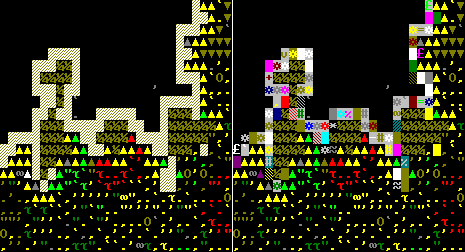- v50 information can now be added to pages in the main namespace. v0.47 information can still be found in the DF2014 namespace. See here for more details on the new versioning policy.
- Use this page to report any issues related to the migration.
Difference between revisions of "Soil"
LethosorBot (talk | contribs) m (LethosorBot moved page DF2014:Soil to Soil: Migrating v50 page (3860/4618) (content)) |
Revision as of 03:58, 20 December 2022
v52.04 · v0.47.05 This article is about the current version of DF.Note that some content may still need to be updated. |
Soil is the name for the various kinds of ground that can be planted on (both above and below ground) without irrigation using water. In Dwarf Fortress, the category of "Soil" includes all types of sand, clay, ooze and any "non-stone" layer equally, even if you or I generally don't associate that substance with "growing plants".
"Soil" in other Languages
|
| Topsoil | Tile |
|---|---|
| Loam | ░. ≈ |
| Loamy sand | ▒. ≈ |
| Peat | ░. ≈ |
| Sandy clay loam | ░. ≈ |
| Sandy loam | ░. ≈ |
| Silt | ▓. ≈ |
| Silty clay loam | ░. ≈ |
| Silt loam | ▒. ≈ |
| Ocean Floor | Tile |
| Pelagic clay | ░. ≈ |
| Siliceous ooze | ▒. ≈ |
| Calcareous ooze | ▒. ≈ |
| Sand | Tile |
| Sand (tan) | ░≈ ≈ |
| Black sand | ▓≈ ≈ |
| Red sand | ░≈ ≈ |
| White sand | ▓≈ ≈ |
| Yellow sand | ▓≈ ≈ |
| Clay | Tile |
| Clay | ▓. |
| Clay loam | ▒. |
| Sandy clay | ▒. |
| Silty clay | ▓. |
| Fire clay | ▓. |
Notes:
- The "topsoil" types listed in the upper part of the table do not count as sand for glassmaking, even if their names include the word "sand" - only those in the "Sand" section are usable for this purpose.
- The 3 "ocean floor" layers are only found under deep ocean tiles, usually far out from any embarkable site. Thus, they can rarely, if ever be encountered, in either fortress mode or adventurer mode.
- Soil layers marked with ≈ are capable of supporting an aquifer.
- The clay types listed at the bottom can be used for making ceramic items. Fire clay produces stoneware, while the other types produce earthenware.
In previous versions, types and quantities of available soils were listed at the bottom right of the fortress location selection screen; in the current version, however, it will only indicate the presence of soil and whether it can be used as clay.
Digging into soil does not generate any byproduct materials, unlike digging in rock, and also is a much faster process which makes it much easier to create storerooms and other large areas of empty space, and to train miners.
Soil cannot be smoothed, which makes it more difficult to make high-value rooms or pierce aquifers, and impossible to carve fortifications, tracks, or engravings.
Building a farm plot or road or removing a construction on top of soil will cause it to become "furrowed", making it appear with the ≈ and ~ tiles. Furrowed soil — including furrowed subterranean soil — will gradually smooth itself out, at which point grass and other vegetation will begin to grow. Sand always appears as ≈ and ~ and cannot become furrowed - as such, sand roads do not last as long as those made on ordinary soil.
Trees and Shrubs
Once you discover the caverns, subterranean trees and shrubs will begin to grow on any subterranean soil.
Kaleidoscopic soil
If the game somehow fails to assign any soil materials to the current region's geological layer definitions (e.g. if the [SOIL] or [SOIL_SAND] tokens are removed), then when the game attempts to determine the material used by a given soil tile, it will return a random number in order to alert the user that something has gone wrong. As a result, the tile's appearance will rapidly change, and mining will yield a random stone, gem, or unusable boulder made of metal or other generated material and leave behind a floor composed of the original layer material, assuming the mining job does not randomly cancel due to the selection of an undiggable material such as slade.
The same thing can happen with layer stone tiles if no materials are marked with an appropriate layer type (such as [IGNEOUS_EXTRUSIVE] or [SEDIMENTARY]).
| More: Gems • Metals • Stones | |
| Creature | |
| Plant | |
| Creature/Plant |
Alcohol • Cloth/Thread • Extract (Golden salve • Gnomeblight • Honey • Royal jelly • Syrup • Venom) • Glob • Liquids • Soap |
| Inorganic |
Metal • Milk of lime • Soil (Clay • Sand) • Stone (Ash glaze • Earthenware • Gem • Gypsum plaster • Porcelain • Quicklime • Stoneware • Tin glaze) |
| Hardcoded | |
| Glitch | |
| See also: Material science | |
| Topsoil | |
|---|---|
| Ocean floor | |
| Sand | |
| Clay | |

